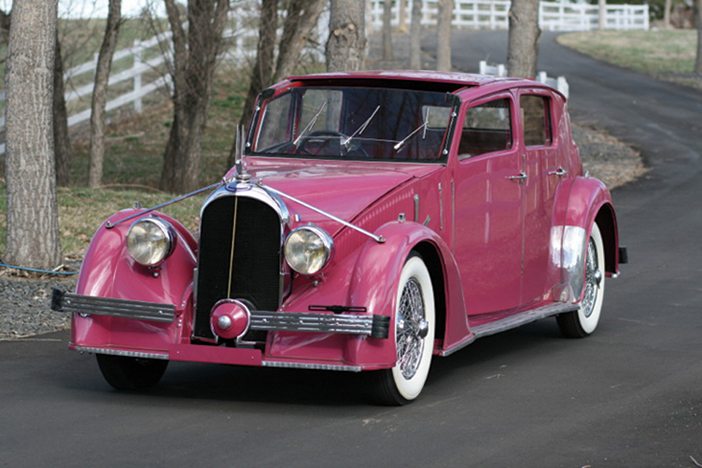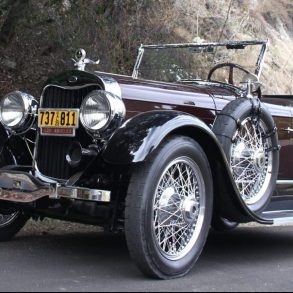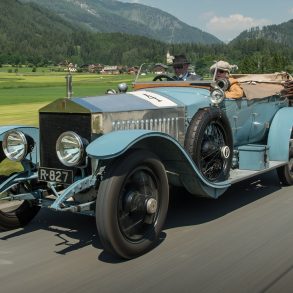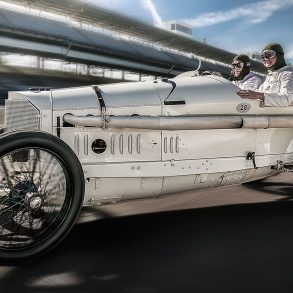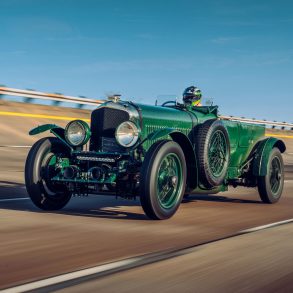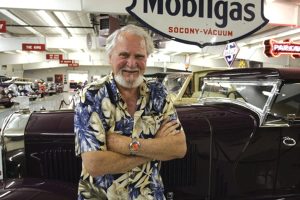
Cussler owns a large collection of classic cars, several of which (driven by Pitt) appear in his novels.
VR: How did you start writing?
CC: My wife had a job with the local police department working nights doing dispatch and secretarial work. So it worked out really well, I would get home from my job as a copywriter in advertising, feed the kids and put them to bed and soon realize I have nothing to do. Then it hit me, maybe I’ll write a book. I didn’t have the great American novel in me so I thought I would do a little paperback series. I went out to the library and checked out all the Inspector Dupont and Edgar Allen Poe books at first, then Sherlock Holmes, Mike Hammer, I studied them all. Then I thought, what can I do that’s different? So I had been fiddling around the water and that’s how it all started.
VR: How did you you first decide to incorporate classic cars in your novels?
CC: It was right from the first one, I had Dirk Pitt driving a Cobra and in the second book the villian drove a Maybach Zeppelin. I had never owned one, it took the third book before I put my own cars in there.
VR: Did you start collecting cars before you started writing your books?
CC: Not really, I had a 1946 Ford before I started writing the books and then as time went on I started my collection.
VR: As the books progressed, the cars became a central focus, how do you decide what cars to feature in each novel?[pullquote]
“I really got carried away on that Voisin. They had that Art Deco thing going on in those days, and so most were just painted black, I just said to myself, ‘What the hell!’ ”
[/pullquote]
CC: I just pick them out of the air, really.
VR: Do you have a car in mind that fits the theme of the book when you write in a particular car?
CC: Not really. It just comes out when the chapter comes to introduce the car.
VR: What was the first collector car that you bought?
CC: The first collector car would have been the Hispano-Suiza H6C. The interesting story about that one was that my wife and I were driving in California and drove by this huge field and here were all these nifty old cars. It was the Buena Vista Concours and there was this celebrity car auction run by Leo Gephart with Andy Griffith doing the auctioneering. So we were watching and I had about three Martinis and was about to walk out when this Hisso went across the block. Bidding got to $35,000 and I thought that was kinda cheap for that car since it was beautifully restored and everything, so, in my drunken haze I bid it up to $50,000 and got it. I stood there for a minute when they said “sold” and thought “my God what have I done?” I had never written a check for more than $500 in my life before then!
VR: How did your wife take it?
CC: She was great, she was an old car nut herself.
VR: Had you ever driven anything that old before?
CC: Oh yeah, the first car that I owned was a 1923 Buick. I bought it as a joke since I also had this old 1925 Auburn sedan, it was a big, black limousine. My buddies and I used to pile in that great big thing and we’d go to football games dressed up as gangsters with overcoats and hats. We would smoke cigars clenched in our teeth, it was great.
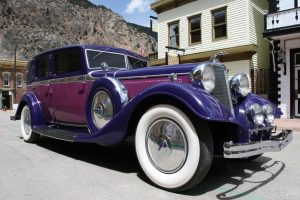
VR: Where did you grow up?
CC: Alhambra, California. I did the whole bit, the hot rods and the surfing and all that stuff.
VR: Were you a car nut from the start?
CC: I think so, because there again— building that 36 … let’s call it a hot rod and I had the Auburn at the same time just for fun—we had a Model T that’s right—we had a Model T with my buddies, it was great fun. I always liked the old cars, I don’t know why. Back then my buddies were all into hot rods, some of them just kept their Model A Fords.
VR: You were at the beginning of Southern California car culture then, weren’t you?
CC: Oh yeah, it was really early, I was in it from the beginning. I got my first car in 1946—I think it was 1946 and we worked on building it. We used to go down to Iskendarian’s shop, it was a small little place back then and it was so cruddy with all the cams and everything just lying around. Hell, I remember when I was 14, my buddy and I used to go out on our bicycles and ride around at night. You know, it just so happens that about three blocks away from where we lived Jim Rathman (winner of the 1960 Indianapolis 500 and the 1958 “Race of Two Worlds” in Italy) and Jack McGrath (who dueled Bill Vukovich at Indy in 1955) were building hot rods and so we’d go out (laughing) to what we used to call the “midnight auto supply” and we’d steal the parts and come back and build these cars. That was the early days.
We used to go out to the dry lakes too, in fact, once we got off on the wrong road, we were coming in at night and it was pitch black. We could see the fires were all burning out there. We had a Boy Scout flashlight and I was holding it out the window and all of a sudden it was crash!, scratch!, some damn farmer had stretched out a barbed wire fence across the road and we had driven right through it. Well, I had been holding this flashlight out the window, see, and got cut up pretty good with it hanging out there, I still carry those scars (pulls sleeve back to reveal scars). Yeah (laughing), when we got to where all the cars were, we went and found an ambulance. The doctor there asked, “How’d that happen?” Well, I said a hood fell on it and he wasn’t buying it. But he took mercy on me and decided to stitch me up anyways. I had to stand there and it was only about three stitches but he had this big upholstery needle. There were 20 people standing around watching and it was pretty tough. I had this grin on my face but I was ready to die inside. That was the kind of stuff we used to do growing up.
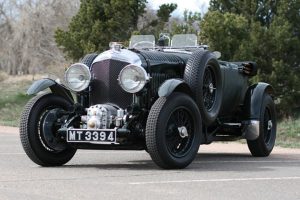
VR: Were you involved in racing back then?
CC: No, I couldn’t afford it really. I had found a job driving a truck for a parts house. I would make so much money, which wasn’t very much, and go out and buy something for the car, a grille or something and a month later it would be something else to buy like an exhaust kit. I never had enough money to spend on racing. It was a long process but I finally finished the Ford by the time I went into the service.
VR: After the Hispano-Suiza, what came next?
CC: A 1921 Rolls-Royce Silver Ghost. The nice thing was Leo Gephart, who ran the auctions, the nice thing was is that he would take my checks and he didn’t know me from Adam. I bought a few cars from him since then, of course. That was really my first introduction and then I started going to the auctions. Eventually, a friend of mine who worked with all the auctions and stuff started to restore my cars and we got a warehouse to store them in. He would work on the restorations and I would store the cars. Unfortunately, he died suddenly. Then we got another warehouse and finally my daughter got involved and we turned the collection into a museum. She did a marvelous job with it and now it’s just spectacular and a sight better than the frst warehouse.
VR: A number of your cars are, um, colorful.
CC: I get carried away with the colors, everybody laughs at that.
VR: How do you decide on colors? What palette are you choosing from when you decide to paint these cars?
SB: I don’t know, sometimes, like on my Locomobile there was this restoration shop doing this Packard that was light tan with blue fenders. I thought it was really beautiful, so I took that scheme and used it for the Locomobile. All the rest were just kinda made up. I really got carried away on that Voisin [a 1936 Voisin C-28 painted pink]. They had that Art Deco thing going on in those days, and so most were just painted black, I just said to myself, “What the hell!”
Oh, Otis Chandler and I used to get in arguments over it, he would say, “Why would you do that?” I would say, “I don’t know.” He always went to Pebble Beach, doing Class A restorations and I never did any of that. Even my family and I would get into fights with them telling me, “I hate that color!”

VR: When Dirk was 16, what would he have driven?
CC: Great question. No one’s ever asked me. He probably would’ve driven my 1936 Ford.
VR: Is there one car over all these years that got away that you regret?
CC: Probably about 35 of them. The first one was a Maybach Zeppelin back in the 70s. I bid on it for a ways then stopped at about $45,000. Sometimes I’ll see it at a concours (shakes head). I remember I passed up on a pair of Delages at $13,000 for both, but one was kind of rough so I passed (laughs).
VR: What is your favorite car?
CC: It’s like somebody asking me about my favorite book, I like them all for different reasons. Sentimentally, they are all special. I wouldn’t pick out just one to say that’s my favorite. My favorite car to just get in and drive is the Blower Bentley. That’s great fun to get behind the wheel and just blast around in.
VR: When you collect, do you have anything in mind or do you wait to see what rolls across the block?
CC: Well … like most guys I’ve bought a car on impulse (laughs), but I usually have something in mind although I’ve been blown away sometimes just sitting there when a car rolls across that you want but then sells for something ridiculous. Several years ago though, I remember, I had always wanted that 1935 or ’36 Stutz DV-32 Super Bearcat. I first saw it some years before but it was really a mess back then. It was a Number 5 if anything (laughs). The guy sitting next to me at the auction asks, “You bidding on that?” I said, “Yeah, I think I’ll bid.” He looks over at me and says that he likes it too. I looked him right in the eye and told him, “I’m bidding $26,000. If you bid $26,005, then it’s yours.” Well, it sold at $120,000 and we both just sat there looking stunned. Well, in 2009, it comes up for auction again, this time at RM. I decide that I am going to get this car whatever it takes and started to bid. Well there’s this phone bidder from Italy who keeps matching my bid over and over again. After a while I could see that I couldn’t get him because he wouldn’t stop no matter what I bid so I pulled out. That was a shame. [Ed. Note – The car eventually sold at $594,000]

VR: What was the worst car that you ever bought?
CC: Oh, I bought a Packard Darrin and looked it all over and it seemed just fine. They did a beautiful job with this thing. My crew got a hold of it just to clean up the cosmetics a bit and they were starting to get into it when we realized that it must have been underwater or in a flood or something. I mean it was so bad it was unbelievable. Now Packard Darrins go about a couple hundred thousand at auction and this car, well … we must have put $350,000 into it to make it right. But it happens you know … but it’s all great fun.
VR: Have you ever gotten involved in vintage rallies or tours?
CC: I should participate more but everytime one comes up I have to be away on a book tour or something like that. I have only been on about three, but they’re all wonderful. I liked the Copperstate and, of course, the Colorado Grand is a nice one, everybody loves going on them. I’ve got friends and all they do is go on tours and they absolutely love it.
VR: How is writing similar to car collecting for you?
CC: I think probably what collecting and writing both share is perseverence. You get an old car that you want to restore and it can take years. The books are the same. Once you start a book and write chapter one you have to finish it. You just have to see them both through to the end no matter how long it takes.
VR: What would you tell people about your new book?
CC: It’s called Built for Adventure and most of the cars in it were used in my novels. It’s one of those things, I had always wanted to do a car book. My youngest daughter stepped in the picture and really got into it, she laid it out and got the pictures taken and everything. It’s quite wonderful and gives you a glimpse into the collection and how the cars work into the novels. I talk about the history of each car and how I acquired them. It’s really neat to get a chance to combine both parts of my life.


